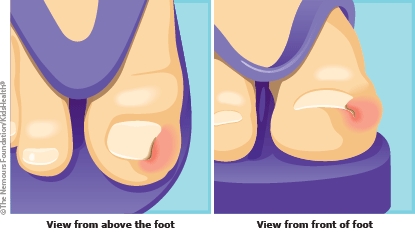What Is an Ingrown Toenail?
A toenail is ingrown when one or both sides of the nail begin to grow into the skin next to it This can lead to pain and swelling. Infection can happen because of the bacteria that hang out on the feet and in shoes. Ingrown toenails usually happen to the big toes.
How Do Ingrown Toenails Happen?
The most common reason for ingrown toenails is cutting toenails too short. When people cut their nails too short, the skin on the sides can cover the corners of the nail. This causes the nail to grow back into the skin. Nails that are ripped instead of cut or cut in a rounded shape also tend to become ingrown because they don't have clear corners. As they grow, a new corner grows under the skin and gets stuck.
Other common causes of ingrown toenails include:
- Shoes that don't fit well. Shoes that are too tight can push the skin on the sides of the nail up over the nail, forcing the nail to grow in. Shoes that are too short also can cause nails to grow into the soft skin.
- Toe injuries. Some severe toe injuries can make the nail fall off. If that happens, the new nail can grow back ingrown.
- Repeated activity. Sometimes, simply repeating the same activity — like kicking a soccer ball — over and over again can lead to ingrown toenails.
How Can You Tell if a Nail Is Ingrown?
Signs of an ingrown toenail include:
- pain
- swelling around the ingrown edge
- pink or red skin
If an ingrown toenail becomes infected, signs might also include:
- pain that gets worse
- liquid or pus discharge
- a warm feeling
- a bad smell from the toe

How Can I Care for an Ingrown Toenail?
Ingrown toenails, if caught early, can be treated at home without a doctor visit. If you notice a slight pain and see that your nail is starting to grow into the skin along the side, you can relieve the pain and try to avoid infection. Try soaking your affected foot in warm saltwater for 20 minutes at a time, 2–3 times a day, to ease discomfort. To make saltwater, get a bucket of warm clean water or fill a bathtub just enough to soak your toe. Add 1–2 teaspoons of Epsom salt (available at drugstores or grocery stores). Regular table salt works OK too if that's what you have.
To prevent the nail from settling back into the skin, try to relieve the pressure by placing a piece of a dry cotton (like from a cotton ball) under the corner of the nail that is growing into the skin. Put antibiotic cream on the irritated area twice a day— this can help prevent infection.
If the pain continues or seems to be getting worse, call your doctor right away.
When Should I See the Doctor for an Ingrown Toenail?
For something minor like an ingrown toenail, it may seem like overkill to visit the doctor. But if an infection sets in, ingrown toenails can be serious and almost always need care by a doctor or nurse.
If you notice any of the signs of infection, like discharge, warmth, or a bad smell, contact your doctor, who may ask you to see a podiatrist (foot specialist). Sometimes the podiatrist needs to remove the corner of the nail that is stuck and drain the pus or liquid that has built up in the skin. Not to worry, though — first the doctor will use medicine to numb the toe and you will feel much better when it's done.
If the nail keeps growing back into the skin, sometimes the doctor will do a small surgery to remove a larger section of the nail or, rarely, the whole nail. Taking care of the toe after an ingrown toenail is removed is almost as important as the surgery itself. Following your doctor's directions after surgery will help you prevent infection and make the ingrown nail less likely to happen again.
What Else Should I Know?
To avoid ingrown toenails, cut toenails straight across and long enough so the corners are not tucked down into the skin. Don’t rip or tear toenails. Being careful when trimming your toenails can help avoid problems with ingrown nails later.



